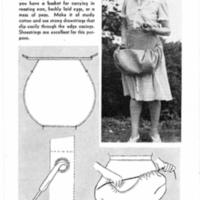Dresses and Aprons for Work in the Home
Title
Dresses and Aprons for Work in the Home
Creator
Date
1944
Relation
Farmers' Bulletin Number 1963
Excerpt
If you are a homemaker doing your own work, then, like the rest of the busy world of workers, you want clothing suited to your job. A dress that restricts when you reach or bend, that twists or gets in your way when you stoop or climb may be as fatiguing as a poorly planned kitchen. Yet there are homemakers who give less attention to the selection of their work garments than they do to choosing kettles and pans, often buying a dress or apron merely because it has heart-shaped pockets or perky ruffles. Actually, the beauty of a dress depends not on decoration alone, but first and foremost on basic cut and design features which make it possible for the dress to follow the movements of the body gracefully and harmoniously.
Keeping in mind a homemaker's need for clothes that are comfortable and saving of time and energy, the Bureau of Human Nutrition and Home Economics has designed the dresses and aprons shown on the following pages. Commercial companies have reproduced these designs in patterns, thus making them available to home sewers.
Each of these designs meets the following tests as a functional garment:
• Free action and coolness for comfort.
• Safety features for work around the stove, for stooping, for getting up and down on chairs or ladders.
• Time- and energy-saving features that make a garment quick and easy to put on — quick and easy to iron. It must have pockets that ore useful and are placed where they can be reached without fumbling.
And for the homemaker who sews, the functional dress must be simple to make.
• Durability both in material and workmanship.
• Attractiveness based on usefulness and comfort.
Keeping in mind a homemaker's need for clothes that are comfortable and saving of time and energy, the Bureau of Human Nutrition and Home Economics has designed the dresses and aprons shown on the following pages. Commercial companies have reproduced these designs in patterns, thus making them available to home sewers.
Each of these designs meets the following tests as a functional garment:
• Free action and coolness for comfort.
• Safety features for work around the stove, for stooping, for getting up and down on chairs or ladders.
• Time- and energy-saving features that make a garment quick and easy to put on — quick and easy to iron. It must have pockets that ore useful and are placed where they can be reached without fumbling.
And for the homemaker who sews, the functional dress must be simple to make.
• Durability both in material and workmanship.
• Attractiveness based on usefulness and comfort.
Publisher
U.S. Department of Agriculture
File(s)
Dresses and Aprons for Work in the Home Cover.jpg
(image/jpeg)
Dresses and Aprons for Work in the Home 2.jpg
(image/jpeg)
Dresses and Aprons for Work in the Home 3.jpg
(image/jpeg)
Dresses and Aprons for Work in the Home 4.jpg
(image/jpeg)
Dresses and Aprons for Work in the Home 5.jpg
(image/jpeg)
Dresses and Aprons for Work in the Home 6.jpg
(image/jpeg)
Dresses and Aprons for Work in the Home 7.jpg
(image/jpeg)
Dresses and Aprons for Work in the Home 8.jpg
(image/jpeg)
Dresses and Aprons for Work in the Home 9.jpg
(image/jpeg)
Dresses and Aprons for Work in the Home 10.jpg
(image/jpeg)
Dresses and Aprons for Work in the Home 11.jpg
(image/jpeg)
Dresses and Aprons for Work in the Home 12.jpg
(image/jpeg)
Dresses and Aprons for Work in the Home 13.jpg
(image/jpeg)
Dresses and Aprons for Work in the Home 14.jpg
(image/jpeg)
Dresses and Aprons for Work in the Home 15.jpg
(image/jpeg)
Dresses and Aprons for Work in the Home 16.jpg
(image/jpeg)
Tailored Princess Dress.jpg
(image/jpeg)
Pull-Over Dress with Ties.jpg
(image/jpeg)
Jumper Apron.jpg
(image/jpeg)
Kitchen Jacket.jpg
(image/jpeg)
 An official website of the United States government.
An official website of the United States government.





















